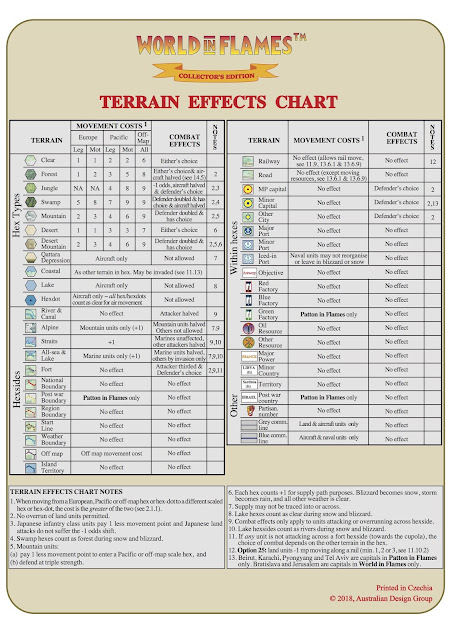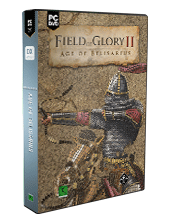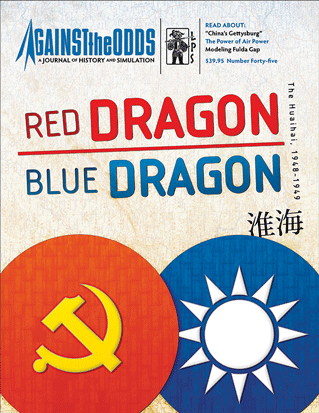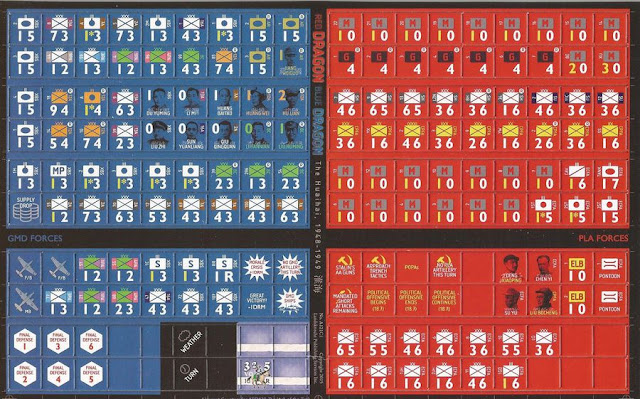Instead, for all of us there are 34 essential single-man counters with historical names and faces [where still available from the archives].
Being in essence a solitaire game, there are several decks of attractive cards. The core of them are the Soviet and German decks, with additional Tactic cards and Support Cards for more detailed and difficult levels of play. I hasten to add that this is "difficult" in the sense of winning, not understanding!
This factor leads me perfectly to the rule book. For those who have at times complained about the clarity of rules in parts of
DVG games [an aspect I've often disagreed with], these rules are excellent. They are not as extensive as many in the
Leader,
Field Commander or
Warfighter series and are clear and thorough, with some of the best illustrated examples of every element of the game that I've seen from any games company.
An overview of the turn presents you with an elegant simplicity of three Phases: the Soviet Card Phase, the Wermacht Card Phase and the Soviet Counter Phase.
In the Soviet Card Phase, you draw four cards and use them to perform 3 Actions [in the right circumstances 4 Actions]. Each card has 2 different Actions on them. So, a typical turn will provide a maximum of 8 Actions to choose from, but there are restrictions as you cannot choose both of the Actions on a single card. In addition, your deck of 28 cards is seeded with 3 Fog of War cards that have no Actions on them. Consequently sometimes your choices will be slightly more limited and, as the game progresses, up to 4 more FOW cards may be added to your deck.
A sample of the dual-use Soviet Action Cards
As the game lasts for a maximum of 21 turns, your Soviet Deck will have been cycled through completely twice before the end of the game. Initially some choices may not be viable as the units or necessary tokens may not yet be available to perform them and, as the game progresses, the states of Suppression, Exhaustion or Disruption will prevent other choices. In case you think that this may make the game rather limited, it doesn't.
It simply adds to the rampant tension throughout the game, as there are three sudden death conditions whereby you lose:- if a Wermacht Counter advances beyond the end of its track on the central board, if there are no Soviet units left in Pavlov's House and if you place a 2nd Disrupted Token in the 62nd Command Post location on the right hand map section. Even if you survive to the end of the game, you still have victory points to add up to see your level of success or failure from Epic Victory to Major Defeat!
I love this aspect of the game, as it means that you have to pay attention to your actions on all three sectors of the mapboard. This is also essential, because what you do in one sector will directly impinge on what you can do on other sectors. [If you don't want any advice at all, I suggest you skip over this short section in brackets. Two tips then - early in the game I suggest [1] you make sure that you get more food into Pavlov's House and [2] you position some anti-aircraft guns.]
A rush of German units and Pavlov's House falls!
Moving on to the Wermacht Phase, this is much simpler and easier, as there are no choices to be made. You simply draw three cards, one at a time and carry out the Action on each one. At first this will need you to refer to the rule book until you become familiar and easy in executing them, but it's surprising how soon that happens and how easy it is using the rule book. The Actions are the following: Attack Defender, Suppress Defender, Attack Building, Bomb Stalingrad, Place a Wermacht Unit and Assault.
Some of the Actions on the Wermacht Cards
Included in the Wermacht Deck are three special cards called Resupply. When one of these occurs, the Soviet player must feed his troops in Pavlov's House and any that cannot be fed are eliminated. If you cannot feed any of them [i.e. there are no Food Tokens in Pavlov's House], then they all die and you LOSE immediately! Once this has been done, the card is turned over to its Storm Group side which allows the Soviet player to launch a major Assault in a later Soviet Card Phase, if the necessary card and circumstances allow. If successful, you gain the card and its VPs towards your score at the end of the game [if you survive that far!]. Whether successful or not, you run the risk of any or all of your units that you assigned to that Assault failing a die roll and ending up in the dead pile.
A very good point is that the Storm Group card remains on the board until either you decide to launch the Assault or it is replaced when the next Resupply card turns up. The only aspect of this I don't like is that you know exactly when each of these cards will occur. However, this is an important feature for your planning and creates another of the fine points of tension in the game as you struggle to get food into Pavlov's House while time ticks away.
The last Phase, the Soviet Counter Phase, allows you to move three men within Pavlov's House and then carry out three Actions. Most Actions result in the man becoming Exhausted [a simple flip of the counter to its shaded reverse side]. As it takes an Action to flip a man back to his active side, you need to build up a team of combatants and make careful use of the few special personages [obviously Pavlov is one of them] who can spend one Action to flip three other men back to active.
There are so many good features in this section of the game. Here are just a few to whet your appetite. Two men with the same attribute, located in the same position and with the necessary weapon counter - e.g. machine-gun/anti-tank weapon or mortar - are needed to fire each of these type of weapons. A man with the Forward Observer attribute is needed to fire an artillery unit that has previously been positioned on the Volga sector of the map. The need to bring men into the house with a range of skills. The utter simplicity of the Line of Sight rule - there are three colours of location in the house for the Soviet units and a matching three colours of location for your German units. Match colours and your man can see the German unit and fire.
Should you eventually find this all too easy and romp through the basic game as victor [oh yeah, who're you kidding?] or you simply want to see how difficult you can make the task. Then you can introduce one or both of two other decks of cards. The first deck contains the Operational Support Cards [only 8 of them]. These abstractly introduce some of the other famous locations in the Siege of Stalingrad, such as the Barrikady factory or Mamyev Kurgan. These provide you with victory points, but at the cost of removing specific tokens from your stock, if you meet specific requirements. This very neatly and simply simulates the demands of battle elsewhere that make your task even harder here at Pavlov's House.
Half the Operational Support deck
The final cards [30 in number], the Tactics Deck, introduce a whole new level of pain. For the Veteran Level of play you turn up the top card each turn and apply its effects to that turn and then discard at the end of the turn. For the Elite Level[ aka insanely difficult!], you turn up two tactics cards per turn and apply their effects. You have been warned!
A sample of the Tactics Cards
If all this weren't enough, you are offered three other options.
[1] Play a two-player cooperative game, with one player handling the Soviet Card Phase and the other the Soviet Counter Phase.
[2] Play a two-player competitive game with one player Soviet and the other German. If you choose this variant, the German player must use the Tactics Deck and draws four cards from the German Deck at the beginning of the game and chooses which three to use and in which order, while the one card not used is kept in hand. On all subsequent turns, another three cards are drawn and the same process repeated.
[3] A three player game, with two Soviet players and a German one.
All in all, this is a fantastic package with so many options.
Finally just a few thoughts and suggestions on how to learn the game.
[1] Skim through the rule book to gain an overall impression of the types of Action both sides can take, but don't try to absorb at this point how exactly to go about taking each Action. This I feel is particularly true of the Soviet Card Phase.
[2] Familiarise yourself with what sectors of the board each Soviet Action relates by looking at both the Soviet cards and the relevant section of the rule book.
[3] Use the rule book and mapboard to become familiar with what you can do with Soviet units in the Soviet Counter Phase.
[4] Set the game up and draw your first four Soviet cards. Choose three Actions and carry them out by referring to the rule book.
[5] Move on to the Wermacht Card Phase and as you draw each card refer to the rule book to execute the Action.
[6] In the Soviet Counter Phase look more closely once again at the rule book for the choices and carry out three Actions.
The well designed play aid for the Soviet cards
After several turns following this pattern, you should be getting a good feel for the game and begin to be able to use the very good play aids that summarise Soviet and Wermacht Card Actions. I would also suggest that an even easier and swifter way to learn is if you can play with a friend so that one of you takes the Soviets and the other the Germans and then swop roles. That way you can focus attention on one side's rules at a time.
By now you should be well aware of my liking for this game. I rate this as one of
DVG's best games, ticking all boxes for quality of all components, one of their very best rule books, ease of rule assimilation, very good play aids and highly immersive, tense game play. Overall I still
personally give the edge to the
Warfighter series, but the ease of set-up and being straight in to play probably means that it will hit my table more often. For those who tend to fight shy of the preparatory planning in many of
DVG's games, I suspect
Pavlov's House is going to hit the sweet spot perfectly.
There can be no other conclusion than this should be in your collection.
US price $59.99 from
DVG
UK price £54.99


































Follow Us